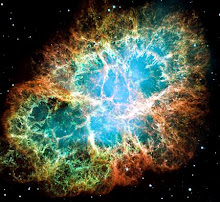Astronomers have recorded a supernova in real time: the death explosion of a massive star that is typically only ever spotted days after the blast.
In studies that appear today in the British journal Nature, four international teams of astronomers say the extraordinary blast was preceded by a short, sharp burst of gamma rays. This provides the first confirmation of a theory that supernovae follow an “early warning signal” of this kind, they say.Supernovae occur when a huge, mature star runs out of fuel and catastrophically and explosively collapses in on itself. The edge of a blast – called the ‘shock breakout’ – is a wave of energy that ranges across the frequency spectrum.
On February 18 this year, an orbiting U.S. sentinel, the telescope Swift, picked up a gamma-ray burst (GRB) in a star-forming galaxy about 440 million light years away, towards the constellation of Aries.As it swivelled in the direction of the blast, Swift also relayed its discovery to major ground-based and space-based observatories. The combined data from their sensors has been pieced together to give a picture about what happened over the next 17 days.
GRBs have long been associated with the aftermath of supernovae. They are typically huge releases in energy: in a few seconds, they can spew out more energy than the Sun will do in its entire expected lifetime of 10 billion years.But this GRB was highly unusual. It lasted almost 40 minutes, whereas a typical GRB only lasts a few milliseconds or tens of seconds at the most, and it was remarkably weak, too – a mild type of GRB known as an X-ray flash.
The astronomers believe that this burst was a high-energy jet that pierced through the doomed star from its collapsing core. In essence, it was sending out a warning that a supernova was imminent.Suddenly, as the GRB faded away, the massive star blew itself into smithereens, sending out a “slightly aspherical” shockwave that rocketed across the heavens. The star’s glowing remains were confirmed optically two days later and classified as supernova SN 2006aj.“Usually these events are not detected until after the supernova has brightened substantially in the optical wavelength, many days after the initial explosion,” said Keith Mason, chief executive of Britain’s Particle Physics and Astronomy Research Council, which operates an ultra-violet/optical telescope aboard Swift. “But on this occasion we were able to study the remarkable event in all its glory, from the very beginning.”
One analysis, led by Alex Filippenko, a professor of astronomy at the University of California at Berkeley, suggests that the star had a mass of about 20 times that of the Sun before it blew apart.The remains of a supernova can become a neutron star – a fast-rotating star that pulses with high energy – or, in the case of very massive stars, a black hole – an object whose gravitational pull is so great that not even light can escape from it.
Supernovae have long played an important role in superstition and knowledge. A supernova spotted by the Danish astronomer Tycho Brahe in 1572, which lingered for a further 18 months, helped overturn the notion established by Aristotle that the Universe was fixed and unchanging.Tycho’s star had such an effect on the popular mind that it was reputedly the inspiration for the celestial portent in Shakespeare’s “Hamlet”.
Just In Case The World Explodes In 42 Hours..







No comments:
Post a Comment